Besides, I’m going to make a couple of suggestions that all the experts will argue with (including ending my sentence with a preposition, well, if you ignore the parenthetical anyway).
Two ways to avoid crying over your cut onions: First, keep them in your refrigerator. Or at least keep a week’s worth in your refrigerator (if you grow them by the acre or buy them 50 lbs. at a time). Second, cut the root end off first (that’s the one with all the little tendrils attached.).

Onions make you cry by turning your eye moisture into sulfuric acid. (It’s the same principle used by the brilliant engineers who ‘fixed’ automotive air pollution by making sulfuric acid instead of nitric acid out of our exhaust fumes.) Most soils where onions are grown have some sulfur in them, and as the onions grow, they concentrate the sulfur compounds that form down at the root end of the bulb, the part that sticks downward into the ground. When you cut open an onion those sulfur compounds mix with the air and form sulfur dioxide gas. And when that gas hits water, we get sulfuric acid. Which makes you tear. And now there’s even more water for the sulfur dioxide to turn to acid. And then you go and wipe your eyes with the back of your hand, and, well, you get the idea . . .
By keeping you onions cold, you reduce the rate at which the sulfur dioxide forms, and therefore have more time to chop before you start to cry.
Now all the experts say (just google ‘onion’ and you’ll see!) to cut the stem end off first thereby trying to avoid all that noxious sulfur in the root end. ‘Course, soon as you cut off the stem end, all those sulfur compounds start to permeate through the onion, so that every slice you make produces more and more sulfur dioxide, and you end up crying.
By cutting the root end off first, you get the outgassing all over with at once; all the sulfur dioxide (well, most of it anyway) leaves the onion instead of flavoring it, and since the gas is cold, it doesn’t rise as fast, giving it more time to mix with more air before reaching head height, and voila, you never know it’s there. If you’re really sensitive, as soon as you slice off the root end, cut out the little core piece there and chuck it down the disposal. Then rinse your knife and your hands and proceed to slice and dice tear free!

The chopping process is really pretty simple. Slice off the root end.

Slice off the stem end.

Cut your onion in half.

Grab a corner and peel each half.
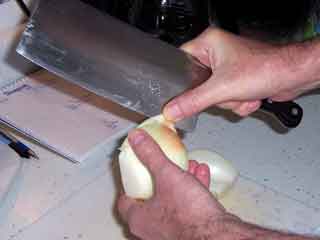
Slap each piece face down on your cutting board and make a series of vertical slices almost to the back end of your onion piece. If one end of your onion is wider than the other, slice from the pointy end toward the wider end. That way, your slices won’t all converge on the same point and the onion won’t fall apart.
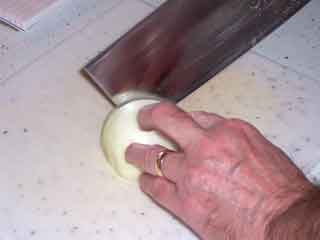
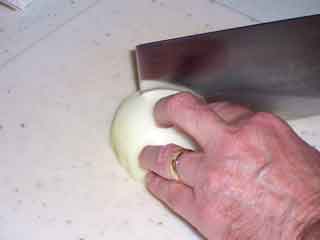
When you get to the last slice, be sure to remember to bring your thumb up above the knife edge. Onions are slippery devils, and I’ve chopped off many a finger part when the blade slid off the surface and right through my thumb!

Then, turn the onion 90 degrees, and slice across your cuts.
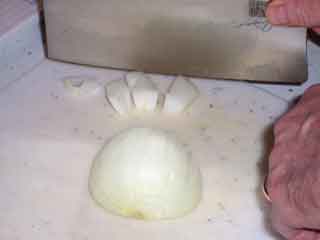
When you get to the end part, where the vertical slices stopped short of the back end of the onion, just turn it around (so you can hang onto the bigger, wider part), cut one more slice, and then cut those last two pieces into wedges.

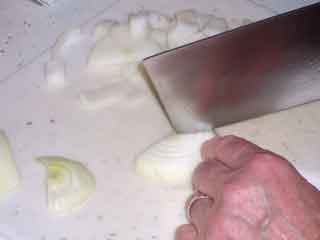
And there you have it: chopped onions, no tears, about 1 minute total elapsed time.

You can control the ‘fineness’ of the chop by how many vertical slices you make and how wide you make your cross cuts. And if you want even finer control than that, before you make the vertical slices, put a slice parallel to the cutting surface about halfway up the onion, almost all the way through. Be careful! Put your hand on top of the onion to hold it! No fingers in line with the blade! And go slowly! If you goof and slice all the way through, you’ll have to finish the old fashioned way!


(Yes, it’s a big knife. Yes, it says Martin Yan. Yes, we’ll talk about knives one of these days . . . For now, go chop some onions!)
No comments:
Post a Comment